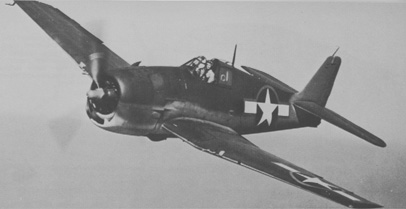Home Page
Grumman F6F Hellcat
United States | Bell P-39 | Bell P-59 | Bell P-63 | Brewster F2A | P-36 Hawk | P-40 Warhawk | F4F Wildcat | F6F Hellcat | F7F Tigercat | F8F Bearcat | P-38 Lightning | Lockheed P-80 | P-51 Mustang | P-61 Black Widow | P-47 Thunderbolt | F4U Corsair
F6F Hellcat
The pugnacious though absently elegant Grumman F6F was one of the five great war winning aircraft, the P-51, the Spitfire, the B-17, the B-24, and the Hellcat. Its life began in early 1942, when the USN realized that they had better build a fighter that could match the Japanese A6M Zero. Fortunately for the Americans, a sole A6M crash landed in the Aleutian Islands during a diversionary raid just before the strike on Midway. The aircraft was only slightly damaged, and after brief repairs it was flown my many US test pilots. They remarked about its maneuverability but the plane was light and fragile, and lacked much firepower and protection. From these weaknesses evolved the F6F, which boasted a heavy, sturdy airframe, lots of firepower, and armor plates over weak spots. A mere 13 months after the first flight of the F6F, the Hellcats were fighting the Japanese over Marcus Island, in August 1943.
The F6F used the most powerful radial engine available, the Pratt & Whitney 2,00hp Twin Wasp. Maximum speed was about 375mph for most models, the later variants attaining up to and over 400mph. Japanese Zero pilots soon discovered that this new fighter was better than their A6Ms, and air battle after air battle ended in Hellcat victory. In fact, the F6F so mastered the A6M that it had an incomparable kill ratio of 18 to 1. The best times for the F6F was during the Marianas Turkey Shoot, a brief period in 1944 where hundreds of Japanese fighters and bombers were shotdown in raging droves.
There were thousands of F6Fs built, 10 in 1942, 2,545 in 1943, 6,139 in 1944, and 3,578 in 1945, for a total of 12,272 aircraft. 4,947 enemy aircraft were downed by the F6F, and another 209 were destroyed on the ground.
Specifications for the F6F-3 Hellcat
Type: Single seat carrier based fighter
Engine: One Pratt & Whitney R-2800 Double Wasp 18-cylinder radial air cooled 2,00hp engine
Performance: Maximum speed 388mph; initial climb 3,300ft/min; ceiling 37,400feet.
Weights: clean 9,00lbs; loaded 12,100lbs.
Dimensions: span 42 ft 10 in; length 33ft 7 in; height 13ft 1in.
Armement: six .50-cal machine guns, provisions for 6 rockets or 2,000 lbs of bombs
First Flight: June 26th 1942
Nations: United States, Great Britain

F6F Hellcat